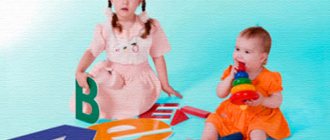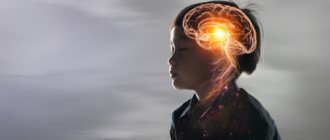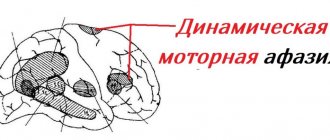Forms of the disease
Conventionally, two main forms of this disease are distinguished:
- sensory alalia: the child does not understand speech, although he can pronounce words;
- motor alalia: the patient has no speech, but he can understand the meaning of speech.
When observing a mixed type of disease, signs of both types of alalia are present. This form is considered the most severe - sensorimotor.
Sensorimotor alalia in a child is characterized by isolated disturbances in the functioning of three important centers of the brain:
- Association Center. With its help, a person can construct sentences and individual phrases.
- Wernicke Center. Responsible for the sensory zone.
- Broca's Center. Responsible for speech (motor area).
The first symptoms of the disorder are usually visible immediately after birth and develop during the period of intrauterine maturation of the fetus. Often diagnosed Sensory/motor
or
Sensorimotor alalia
is set as the main diagnosis for varying degrees of delays in speech and/or psycho-speech development. This is not entirely true: lack of speech or speech understanding is just one symptom of developmental delays. A local pediatrician or specialized specialists such as a psychologist or neurologist can suspect alalia in a child. A patient with a severe sensorimotor form of this disease suffers from delayed speech development. In infancy, such a baby may not utter individual sounds—baby babbling or humming is completely absent. As they grow older, there is a lack of speech: the child does not speak individual phrases, does not try to pronounce words.
Depending on the degree of severity, different forms of sensorimotor alalia are distinguished:
- mild - characterized by the presence of problems in speech development, but they are small;
- severe - with this form, the child may not speak until the age of 12.
Late speech formation, difficulties in speaking, a small vocabulary - all these characteristics, to one degree or another, may indicate the presence of sensorimotor alalia. Children suffering from a mixed form of this disease often begin to communicate using facial expressions and gestures. It is difficult for them to perceive sounds by ear and any noise from the outside, since they are not able to understand the words addressed to them. However, it should be understood that hearing is not impaired during alalia. This means that, with proper correction, it is possible to avoid a decline in intelligence in the future.
Symptoms of sensorimotor alalia can occur with disorders such as ASD, autism, delayed speech and psycho-speech development, then the symptoms are combined with the following symptoms:
- the desire to become attached to individual objects or things;
- avoiding contact with other people;
- timidity, fear of excessively loud sounds;
- crying for no apparent external reason;
- repetition of the same movements in an obsessive manner.
It is extremely important to correctly diagnose so as not to confuse the symptom complex of autism spectrum disorder with a severe form of mixed alalia, since treatment tactics and pedagogical correction will differ.
Currently, there has been significant progress in the development of speech therapy. Based on psychological analysis, important data were obtained on the mechanisms of the most complex forms of speech pathology (aphasia, alalia, general speech underdevelopment, dysarthria). Alalia is one of the severe and persistent forms of speech pathology. Many children with alalia do not acquire language and remain non-speaking or barely speaking even after entering school. Thus, the problem of diagnosing and organizing correctional and educational work for alalia is one of the most important and fundamental scientific and pedagogical problems of the system of preschool and school educational institutions at the present time.
A characteristic or complex symptom complex of linguistic and non-linguistic disorders has a negative impact not only on speech communication, but to a certain extent also on the development of cognitive activity of certain aspects of the personality, and often prevents the achievement of needs and aspirations that are significant for the developing personality.
Thus, all these factors indicate that the teacher, defectologist and speech therapist need comprehensive and deep knowledge about this form of pathology of speech activity in order to be able to analyze the nature of the pathology in future practical work and find optimal ways to overcome it.
This problem is solved mainly through the creation of tests, diagnostic methods, various systems of correctional and speech therapy for both motor and sensory alalia, through the organization of specialized kindergartens and schools, the purpose of which is the early education and upbringing of children with this speech pathology .
At the same time, there are many unresolved issues in the theoretical development of the problem of alalia. All this creates the urgency of this problem.
Many studies in the historical past are devoted to this aspect of the work. Thus, in 1888, a detailed correction of “idiopathic alalia” was presented by R. Cohen. He expressed a judgment about its etiology, the nature of damage to the speech apparatus, the mechanism, symptoms, differential diagnosis and methods of speech education in these children. Alalia/muteness/ was first identified as a separate speech disorder in 1830 by R. Schulthess and was considered by him in connection with articulation disorders.
Significant contributions to the study of alalia were made by G. Gutman, A. Liebmann, M.V. Bogdanov-Berezovsky, R.A. Belova - David, E. Fretels, and at a later time M.E. Khvattsev, V.K. Orfinskaya, R. E. Levina, E. R. Sobotovich, V. I. Kovtikov, V. K. Vorobyova, L. S. Volkova and other researchers.
The work of various authors has identified the features of speech development and the structure of the defect in alalia based on the use of various criteria: physiological, clinical, psychological, linguistic and others. Various forms of alalia have been described, and a method of speech therapy intervention has been developed for various forms of speech underdevelopment. Thus, V.K. Orfinskaya in her book “Development of Thinking and Speech in Abnormal Children” offers differentiated methods that correspond to the characteristics of the forms of alalia she identified. She also tried to theoretically substantiate this problem and show in practice how to implement it.
N. S. Zhukova, E. M. Mastyukova, T. B. Filicheva, B. M. Grinshput, E. F. Sobotovich, and other representatives of the “language” concept highlight the main task of speech therapy - educating children’s ideas about the patterns of functioning language system, about the interaction of its components. They distinguish a number of psychological and individual characteristics that must be taken into account when working with children.
Thus, successes in the study of alalia in the works of the most recent period have been achieved due to the fact that researchers in their activities began to widely rely on the methodology of an integrated approach to the analysis of the defect. And unlike previous periods, when, according to V.K. Orfinskaya, there were more controversial issues and arguments between alalia researchers than generally accepted positions, at the present stage of development of speech therapy there is more in common than disagreement. The general is manifested in the basic principles of understanding the defect, its mechanism, and ways to overcome it.
But despite all the existing developments in the theory and practice of correctional educational training for children with alalia, such fundamental issues as the problems of sensory alalia have not yet received a proper solution, since this problem has caused heated discussions throughout the history of its study. Sensory alalia is less studied than motor alalia. The existence of sensory alalia as an independent disorder even now raises doubts among some researchers; sometimes it is believed that the diagnosis is made without the necessary grounds. The mechanism and symptoms of alalia have not been sufficiently studied. There are also a number of difficulties and shortcomings in the practice of schools and preschool institutions. They boil down to the following:
— weak material base of institutions;
- insufficient methodological and speech therapy training for teachers and educators;
- an insufficiently thought-out system of work for teachers, educators and speech therapists in this area.
— lack of methodological literature.
— there is no continuity between the preschool institution and the primary level of education.
Based on the above, we can formulate the problem of this work. The problem is to identify and consider under what psychological and pedagogical conditions speech therapy intervention is most effectively carried out on children with alalia. What methods, means and forms are most appropriate.
Practical significance.
This work, in our opinion, contains a certain practical significance. Methodological recommendations for parents, teachers and kindergarten workers, observation data show the advantage and all the positive aspects of the work of those educators, teachers and speech therapists whose classes are aimed not only at correcting the defect, but also mainly at the development of the child as a whole.
The work gives an idea of alalia, its forms, etymology, mechanism, symptoms and the choice of directions for speech therapy work.
Based on theoretical developments and research by many scientists, the current state of this problem is revealed and the main issues that will be considered and studied in the future are highlighted.
“The study of such a severe speech disorder as alalia is an extremely promising area and opens up the widest opportunities for researchers. It is no coincidence that the study of severe speech pathologies is attracting more and more researchers. Alalia is an organic disorder, underdevelopment of speech of a central nature - one of the most global problems of our time.” Kovtikov V.A., Elkonin Yu.A. — Mental and speech disorders in children. - L., 1979.
I. _ GENERAL CHARACTERISTICS OF ALALIA.
Any process or phenomenon that is directly studied or investigated has its own positive and most characteristic, typical features that distinguish this or that process or phenomenon from similar ones.
When defining alalia, based on the work of V.A. Kovshilov, we can proceed from the division of all speech disorders into 4 large groups, namely:
- to the group of automotor disorders /in which perception or articulation are primarily impaired/;
- to a group of psychological disorders /in which various components of the speech process are disorganized/;
- to a group of semantic / semantic / disorders / in which the semantic aspect of speech is disrupted /;
- into a group of language disorders / in which the structural and functional side of the language is disrupted - phonemic, grammatical and lexical operations in the process of speech damage /.
Taking into account this and other conditions, we can give the following definition of the pathology of speech activity that interests us.
Alalia is the absence or underdevelopment of speech due to organic damage to the speech areas of the cerebral cortex in the prenatal or early developmental period of the child.
There is an opinion that most children with alalia have (or had in the early stages of their development) often pronounced but multiple damage in both hemispheres of the brain.
The mechanism of alalia is poorly understood. There are different points of view in the study of alalia. Some researchers are disordered functioning. The language mechanism is associated with pathology of motor skills, others with pathology of certain aspects of mental activity, and still others with selective failure in mastering language as a unique sign system. But despite such discrepancies, representatives of different directions agree that the disorder of the language mechanism is based on organic failure of the brain.
During its development, alalia undergoes a number of quantitative and qualitative changes. Children, having mastered relatively simple units of language and the rules of their functioning, for a long time experience difficulties in mastering complex units and rules. Having mastered oral speech, they cannot fully master written speech for a long time.
When determining alalia, the necessary criteria are:
1. Delay in the rate of normal language acquisition.
- Pathological development of language.
3. The presence at certain stages of ontogenesis, to varying degrees of severity, of violations of all subsystems of language.
4. Preservation of hearing.
5. Satisfactory understanding of spoken speech for a certain age.
A very large number of different terms are used to refer to alalia, which reflects different ideas about it and insufficient knowledge of its etiology, mechanism and dynamics. The most common terms are “idiopathic alalia” /congenital/, “auditory muteness”, “developmental aphasia” and “constitutional delay”, “general speech underdevelopment”, “impaired language acquisition”, “language inability”. Examples of rarely used and uninformative terms: “muteness”, “non-speaking children”, “children with severe/profound/ speech impairments”. These terms have an uncertain meaning and many fundamentally different forms of speech disorders can be attributed to them.
Because. that many authors define the boundaries of alalia in different ways /i.e. They consider alalia to be a variety of variants of language development, but recently there is no convincing data on its spread. However, the available data are very limited and contradictory.
It was also found that alalia is more common in males, the frequency ratio between the sexes is 2:1.
According to clinical observations conducted by many researchers, it is noted that compared to impressive/sensory/expressive alalia, it is much more common.
The presented research results and experimental data prove the following basic judgments about alalia:
- Alalia is a systemic underdevelopment of speech, in which all components of speech are disrupted: phonetic-phonemic side, lexical-grammatical structure.
- For children with alalia, not only a delay in the development of the mechanism of expressive speech is typical, but mainly its pathological development.
- Violation of the mechanism of expressive speech is characterized by disorganization of all language systems and the language system as a whole.
II . CAUSES OF ALALIA.
Based on the data provided by L.S. Volkova and others in the textbook. manual "Speech therapy" for students of defectology. fak. ped. In-tov, we note that various authors have identified the causes of alalia. Thus, A. Libman (1901) associated speech deficiency in alalia with intellectual deficiency. A. Treitel considered alalia to be a consequence of a lack of attention and memory, M. Zeeman (1962) emphasized that speech does not develop due to disorders of the brain speech centers (cerebral speech zones). Many other scientists, including M. Beri (1957), M. Baidinova (1961), G. Luchsinger (1970), V.A. Kovtikov (1985) noted the leading role in the occurrence of alalia of natural traumatic brain injuries and asphyxia of newborns. Birth injuries and asphyxia can in some cases be the result of intrauterine pathology. This causes chronic oxygen starvation and leads to a decrease in the function of the respiratory center, which leads to disruption of associative connections that ensure the formation of higher cortical functions of a person, primarily speech and the psyche.
Among the etiological factors, there are also meningitis, intrauterine encephalitis, unfavorable developmental conditions, intrauterine or early acquired brain injuries, fetal intoxication, early childhood diseases with complications on the brain, etc.
Birth traumatic brain injuries and asphyxia of newborns cause local disorders, while intrauterine pathology leads to diffuse damage to the brain substance. Thus, any damage to various areas of the cerebral cortex leads to developmental disturbances in the functioning of speech and non-speech systems.
Various degrees of severity of alalia are observed: from relatively mild disorders, in which speech, although slowly distorted, develops independently from 3-4 years, to severe ones, when the child does not use speech even at 10-12 years. Later, with systematic help, he masters defective and poor speech.
In this paragraph, it is necessary to consider in more detail the reasons for alalia. As a result, it is necessary to note how causes as such are studied at individual stages of the communication process. Biological and social factors and their dialectical relationship are important in etiology.
So, social reasons are stimulation and speech pattern. The social environment stimulates speech development and provides a speech pattern, especially in the early stages. Stimulation is the effect on a child of appropriate speech stimuli /words/ in order to stimulate the reflex and imitate speech activity.
An incorrect speech pattern can also be a cause of speech underdevelopment (for example, imitation of incorrect pronunciation).
This is often combined with other causes of alalia.
In addition to social factors, dysfunctions of the analyzers, mainly visual and auditory, should be noted as possible causes. Violations of the visual analyzer can cause delayed speech development; this should be taken into account when training. However, the auditory analyzer plays a leading role in speech development.
Partial hearing loss - a greater or lesser deformation of perception - has a negative effect on the development of speech and psyche. Absence or early loss of hearing inhibits the reception of information. Spontaneous speech does not develop, it follows that the formation of mental functions that depend on the development of speech, which arise as a result of hearing impairment, is delayed, can be identified at an early age and belong to an independent group of disorders; they are not included in the concept of alalia.
When studying the etiology of alalia, it is necessary to consider the reasons located in the central, expressive part and in more detail the reasons for the social environment,
REASONS FOR THE CENTRAL PART:
Input /receipt of information/.
Input disturbances concern cognitive activity—recognition of perceived forms of speech. In sound-speech communication, cognitive activity is the recognition or identification of the structure of a sound-speech sign, which was previously perceived by ear and stored in memory. According to information theory, the verbal cognitive process can be considered as the decoding of speech sounds, where decoding refers to the recognition of a sign, but not yet the understanding of the content of words.
In oral speech, cognitive activity corresponds to I, expressed in the inability to recognize and remember word structures. If this disorder concerns the area of hearing, then we speak of auditory verbal agnosia /verbal deafness/, if it affects vision, then we speak of visual verbal agnosia /verbal blindness/. Speech cannot develop spontaneously, so the consequence of auditory verbal agnosia is delayed speech development. The functional integrating center connects the heard or seen and recognized sign with its content. Recognition of the content of information is the basis of the cognitive process with which the programming of speech activity is associated. The most complex components of the communication process are carried out in the integrating center.
REASONS FOR V E X P R E S S I V N A P H A T I
The process of speech realization is coordinated by motor systems. Disruption of the activity of these systems at an early age may be a consequence of perinatal encephalopathy. In its severe forms, paralysis of various types and degrees may occur.
Mild forms of perinatal encephalopathy due to minor diffuse changes in the motor systems manifest themselves either in motor lability or in insufficient motor development, sometimes in a combination of both. Motor underdevelopment or retardation makes it difficult to coordinate speech movements, which leads to delayed speech development with motor alalia.
The consequence of severe speech delay is alalia.
A special form with a possible violation of speech development is the relearning of left-handedness. Left-handed children, who were retrained to use their right hand at an early age, often experience developmental delays in some cases. If they are retrained in an inept way by force, then along with a delay and distortion of speech development, disorders may occur*
Causes of social environment - social feedback. The child's speech is directed to his environment. The reaction of others acts as feedback. It is important for the child whether his statement met with approval or refusal, whether it was accompanied by success or failure. Often this psychological moment, so important for the development of speech, is not given due importance. Negative social influence, when a child finds a satisfying response to his statements, inhibits speech development.
Growing up with high demands can lead to neurotic reactions, such as negativism, which negatively affects speech development. The child does not want to speak and speech development is delayed.
From the point of view of understanding alalia, the concept of “hearing muteness” found in old literature can be divided into certain components depending on the predominance of biological, social reasons or their combinations.
So, the reasons that cause alalia are diverse, and many studies by various scientists and the data presented in this chapter also confirm that speechlessness in children can be based on different etiologies.
Hence, the primary diagnosis of alalia is not confirmed in some cases, because The cause of speech underdevelopment may be hearing loss or severe intellectual disability. Only a comprehensive examination of such children with the participation of neurologists can reveal the true structure of the defect. Only studying the possible causes of speechlessness in children will allow specialists to choose the necessary effective forms of correctional and educational work.
Depending on the predominant localization of damage to the speech areas of the cerebral hemispheres, two forms of alalia are distinguished: motor and sensory.
Reasons for the development of sensorimotor alalia in children
Disorders that can lead to the development of this disease often occur during the period of intrauterine development of the fetus. This occurs during the stages of brain formation. Incorrect development of speech centers in young children occurs as a result of the influence of many factors. Here are just a few of them:
- There is a Rh conflict between the child and mother.
- Premature birth, the appearance of a very premature baby.
- The influence of various intrauterine infections.
- An infant receiving a birth injury.
- Fetal hypoxia, asphyxia as a result of wrapping the neck with the umbilical cord.
- Insufficient development of the placenta.
- All kinds of threats in the process of carrying a child by a mother.
The following may influence the appearance of the problem during pregnancy:
- bad habits of the mother;
- leading an unhealthy lifestyle (especially in the first trimester);
- severe toxicosis;
- gestosis;
- receipt of physical injuries by the mother as a result of a fall and more.
In early childhood, alalia can develop due to the baby suffering from purulent meningitis, rubella, encephalitis and a number of other complex diseases. Also, problems with speech development can be a consequence of traumatic brain injury. The disease can be provoked by a hereditary factor or general anesthesia.
Children diagnosed with sensorimotor alalia are constantly at risk. This is due to the fact that such children more often develop endocrine diseases, rickets, various pneumonias, and are more susceptible to acute respiratory viral infections.
In some cases, mixed forms of alalia become the result of serious pedagogical neglect. This often happens in families where parents and other family members show no attention to the child: they practically do not communicate with him or do anything with him. The defect rarely appears in children in problem families where older brothers and sisters grow up.
The diagnosis of sensorimotor alalia can be made to a child aged 2 years or older. During this period, children, as a rule, already understand quite well what others are saying to them and can independently pronounce individual simple words.
Motor alalia
Motor alalia is characterized by the presence of a lesion in the brain. With this form of the disease, there are problems with speech, but intelligence is preserved. The part of the cerebral cortex that is responsible for speech production is affected. This form of pathology usually develops before the age of 3 years; as the child grows older, he begins to have complexes about his condition and uses facial expressions and gestures in conversation.
The main difference between motor alalia is that the child has difficulty speaking without visual perception. If he does not see a specific image, he cannot name it. Only during perception are neural connections formed between the centers of the cerebral cortex. Simple phrasal sentences remain in a rudimentary state, for example:
- "I'm here";
- "Come here";
- “Let me play”;
- “Let's go home”, etc.
Parents are not always able to detect motor alalia in the early stages, which is why they do not immediately turn to specialists. For full treatment, constant monitoring by a neurologist is required. The speech therapist selects a program depending on the specific clinical situation. The mild form is easier to correct; if you contact specialists in a timely manner, the prognosis is favorable.
Symptoms
A child with a speech development problem is immediately visible. Alalia can be determined if the child does not react when addressed by name, does not utter words and individual phrases, and is not able to fulfill basic requests. In this case, the specialist draws up a comprehensive treatment plan, during which it is extremely important that the parents make a lot of their own efforts. Psychologists and neurologists, as well as a pediatrician, will help determine the symptoms of disorders.
A psychologist can identify signs of the disease such as:
- memory problems;
- inability to maintain attention;
- hyperactivity (but the exact opposite phenomenon may also occur - low mobility);
- high rate of fatigue;
- aggression without reason;
- nervous excitability.
It is quite difficult for a child who does not understand what is being said to him to adapt to society. This causes a number of related problems (with health, adequate reactions, behavior).
Sensory alalia
Sensory alalia is characterized by a disorder of speech perception through the sensory organs. It is often confused with deafness because the symptoms and behaviors appear similar to hearing loss. In fact, the child does not differentiate and does not understand sounds; for him, any speech sounds like a set of incomprehensible foreign words. With this pathology, speech is heard monotonous and it is not clear where one word ends and another begins.
Typical symptoms of sensory alalia:
- speech is present, saturated with a large number of incomprehensible monotonous words;
- the child repeats for a long time the same words that he hears from adults;
- there are rough alterations of words, in which syllables and prefixes are swapped;
- The vocabulary is small, consisting of simple words or short phrases.
Children with sensory alalia experience many difficulties in life, it is difficult for them to communicate with peers and study, they are behind in development. To solve this problem, you need to start working with a specialist as early as possible and select a corrective program. The patient is observed by several doctors, each prescribing therapy according to his own profile. Only with joint and coordinated treatment can an optimal result be obtained.
Diagnostics
To make a diagnosis, additional examinations may be required:
- MRI of the brain.
- X-ray of the head. Electroencephalography.
- Neurosonography
Diagnostic tests allow us to understand how much the brain is affected. This is the only way to determine the course of treatment and its main stages. Parents will also have to visit an otolaryngologist and speech therapist. Based on a set of studies, a diagnosis is established.
Remember that alalia does not contribute to a decrease in hearing and intelligence. However, visiting an otolaryngologist, performing an otoscopy and audiometry will help rule out other possible disorders that may also affect speech impairment.
Specialists additionally carry out differential diagnostics, which helps to evaluate a number of significant criteria and accurately determine the form of alalia. The following skills are assessed:
- speech understanding and listening comprehension;
- ability to repeat sounds and individual words;
- the child’s reactions in the form of gestures and facial expressions to spoken speech;
- development of other communication skills;
- dynamics of speech development over time.
It is important to undergo a full examination in order to more accurately select a correction program for the child and treatment format.




